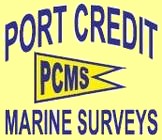 Port Credit Marine Survey & Yacht Delivery |
2. Power & Sail Differences |
 Port Credit Marine Survey & Yacht Delivery |
2. Power & Sail Differences |
| Despite the sometimes petty antagonism between power & sailboats, for this trip there are only four major differences between them. In a survey of sailboats who kept a log I found that between the Great Lakes and Florida they had the sails up for 6-12 hours. Those that did not keep a log claimed they had sailed much more (not likely). | |
| a.) Draught. powerboats heading south are of the trawler or motor yacht type with draughts between 3’ and 4’ ( I was raised in Scotland and can't bring myself to spell it "draft" ). Sailboats drawing 5’ 6” can do most of the inside route but kissing bottom somewhere between the Carolinas and the middle of Florida is a sure bet. Of course anyone drawing more than 3’ 6” ( I mean the boat ) should forget about the inside route from New York Harbour to Atlantic City and any drawing more than 4’ should bypass the inside route from Atlantic City to Cape May unless you are willing to run only with the tides. Don’t forget that most boat specifications were published before the first model hit the water and many changes were made throughout the production runs. Also remember the small type “subject to change without notice” printed on most boats spec sheets. Do not trust the measurements on the literature…..measure it yourself. We met a couple in Wrightsville Beach SC who were waiting to have the keel on their recently purchased Bavaria 42 modified. The broker and the surveyor assured them that they had measured it and the boat did indeed have a 5’ 6” draught as per their requirement and according to the original spec sheet. After buying the boat they discovered it had a 6’ 10” draught. Someone is paying for a very expensive keel modification. |  My Mom, little brother and I with Frazerburgh’s NorthSea trawler fleet in the background. |
| b.) Air Draught. With a controlling fixed bridge height of
56’, some sailboats will have to do a couple
of sections on the outside. With many bridges
much lower, sailboats can spend a lot of
time circling waiting for an opening during the fall rush south and the spring rush north. This can be hard on the
nerves as 10-20 boats try to hold station
in a narrow channel with river and tidal
currents, wind and less than expert boat
handlers. Hang back a quarter mile or so out of the crowd. When the bridge opens you will have lots of time while the mob sorts itself out. Let the gofasts to the front of the line then you won’t have to deal with their wake as they jockey to pass slower boats after the bridge. Actual “air draught” is critical and this too you should measure yourself. More than one boat has lost anometers, antennae, radar arches and occasionally a mast. |
 You’ve seen this boat before but I like it
so much I thought I’d show You’ve seen this boat before but I like it
so much I thought I’d show it again from a different angle |
| If you are doing the Trent, Severn or New
York State canal systems you may wish to
consider shipping your mast to the other
end of the system rather than carrying it
on deck. Crossing Lake Ontario with prevailing
beam seas can be difficult and even dangerous
with 50' of aluminum pipe tied on top of
your boat. It had better be extremely well
secured. Unless you have a bow thruster getting a little sideways in a lock can be a costly excercise with 10' sticking out past your bow and dragging another 10' behind you.. Please give serious consideration to shipping your mast by truck or just admit your error and buy a trawler :) |
|
|
c.) Horsepower. There are the obvious currents and tides
to fight like the Hudson River, the Delaware and Chesapeake Bays but there are also many other narrow cuts
and sounds to be crossed with tremendous
currents. Lower horsepower sailboats have
to pay much more heed to these currents than
the powerboats. Even with our 145hp and 24X20
propeller we could only make 2.4 knots against
the tide in the Elliot Cut south of Charleston. A close study of the tide table is imperative.
More on this in the “Navigation” section. d.) Helm Height. Most cruising power boats have a flying bridge and operating from 12’ above the water is a significant advantage in reading river currents, spotting shoals and judging distances in a crowded anchorage. Laura never has to stand at the bow to see what’s immediately in front of us and its just plain better for sight seeing on the rivers where we can see over the banks without 40' of boat and masts in front of us. See ! Not so many differences considering sailboats will be motoring 95% of the time. |
 Green Turtle Key, people you meet. Green Turtle Key, people you meet. |
|
Chapter 3. Boat Preparation & Maintenance. Back to Index |
|
 |
|